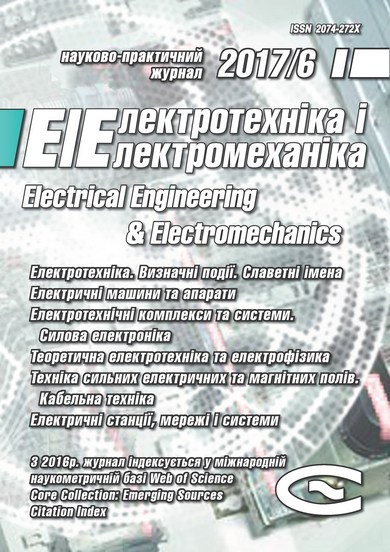TESTING OF NUMERICAL SOLUTION OF THE PROBLEM OF DETERMINING SOURCES OF MAGNETOSTATIC FIELD IN MAGNETIZED MEDIUM
DOI:
https://doi.org/10.20998/2074-272X.2017.6.06Keywords:
plane meridian magnetostatic field, piecewise homogeneous magnetized medium, integral equation, electrostatic analogy, fictitious magnetic chargeAbstract
Purpose. Testing of numerical solution algorithm for integral equation for calculation of plane meridian magnetostatic field source distribution at interfaces of piecewise homogeneous magnetized medium by means of electrostatic analogy. Methodology. The piecewise homogeneous medium consists of three regions with different magnetic permeabilities: the shell of arbitrary meridian section, external unlimited medium outside the shell, and the medium inside the shell. For testing external homogeneous magnetic field effect on spherical shell is considered. The analytical solution of this problem on the basis of electrostatic analogy from the solution of the problem uniform electrostatic field effect on dielectric shell is obtained. We have compared results of numerical solution of integral equation with the data obtained by means of analytical solution at the variation of magnetic permeabilities of regions of medium. Results. Integral equation and the algorithm of its numerical solution for calculation of source field distribution at the boundaries of piecewise homogeneous medium is validated. Testing of integral equations correctness for calculation of fictitious magnetic charges distribution on axisymmetric boundaries of piecewise homogeneous magnetized medium and algorithms of their numerical solutions can be carried out by means of analytical solutions of problems of homogeneous electrostatic field effect analysis on piecewise homogeneous dielectric medium with central symmetry of boundaries – single-layer and multilayer spherical shells. In the case of spherical shell in wide range of values of the parameter λk, including close to ± 1, numerical solution of integral equation is stable, and relative error in calculating of fictitious magnetic charges surface density and magnetic field intensity inside the shell is from tenths of a percent up to several percent except for the cases of very small values of these quantities. Originality. The use analytical solutions for problems of calculation of external electrostatic field effect on piecewise homogeneous dielectric bodies for testing integral equations of magnetostatics and algorithms for their numerical solutions. Practical value. The described method of testing integral equations of magnetostatics and their numerical solutions can be used for calculation of magnetic fields of spacecraft control system electromagnets.References
1. Grinberg G.A. Izbrannye voprosy matematicheskoi teorii elektricheskikh i magnitnykh iavlenii [Selected questions of mathematical theory of electric and magnetic phenomena]. Moscow-Leningrad, Acad. of Sci. USSR Publ., 1948. 730 p. (Rus).
2. Tozoni O.V., Maergoiz I.D. Raschet trekhmernykh elektromagnitnykh polei [Calculation of three-dimensional electromagnetic fields]. Kiev, Tekhnika Publ., 1974. 352 p. (Rus).
3. Mikhailov V.M. Raschet elektricheskikh i magnitnykh polei s pomoshch'iu integral'nykh i integrodifferentsial'nykh uravnenii [Calculation of electric and magnetic fields using integral and integrodifferential equations]. Kiev, EMC HE Publ., 1988. 60 p. (Rus).
4. Polivanov K.M. Teoreticheskie osnovy elektrotekhniki, ch. 3. Teoriia elektromagnitnogo polia [Theoretical foundations of electrical engineering, Part 3. Theory of electromagnetic field]. Moscow, Energiya Publ., 1969. 352 p. (Rus).
5. Simonyi K. Teoreticheskaya elektrotekhnika [Theoretical Electrical Engineering]. Moscow, Mir Publ., 1964. 775 p. (Rus).
6. Mikhailov V.M., Chunikhin K.V. On electrostatic analogy of magnetostatic field in inhomogeneous magnetized medium. Electrical engineering & electromechanics, 2017, no.5, pp. 38-40. (Rus). doi: 10.20998/2074-272X.2017.5.05.
7. Kolechitskii E.S. Raschet elektricheskikh polei ustroistv vysokogo napriazheniia [Calculation of electric fields of high voltage devices]. Moscow, Energoatomizdat Publ., 1983. 168 p. (Rus).
8. Jungerman J.A. Fourth-order uniform electric field form two charged rings. Review of Scientific Instruments, 1984, vol.55, no.9, pp. 1479-1482. doi: 10.1063/1.1137962.
9. Ianke E., Emde F., Lesh F. Spetsial'nye funktsii [Special functions]. Moscow, Nauka Publ., 1977. 344 p. (Rus).
10. Bondina N.N., Volchkov Iu.I., Konovalov O.Ia. Modelirovanie elektromagnitnykh polei. Laboratornyi praktikum [Modeling of electromagnetic fields. Laboratory practice]. Kharkov, NTU «KhPI» Publ., 2007. 168 p. (Rus).
11. Boyko N.I., Bondina N.N., Donets S.E., Levchenko E.V., Mikhailov V.M. Polarization of spherical shells and electric field distribution in biological cell. Tekhnichna elektrodynamika. Tem. vypusk «Problemy suchasnoyi elektrotekhniky», 2002, part 6, pp. 13-19. (Rus).
12. Boyko N.I., Bondina N.N., Levchenko E.V., Mikhailov V.M. Modeling the effect of electric field on objects having a multilayer structure. Electronic modeling, 2002, vol.24, no.1, pp. 70-82. (Rus).
Downloads
Published
How to Cite
Issue
Section
License
Copyright (c) 2017 V. M. Mikhailov, K. V. Chunikhin

This work is licensed under a Creative Commons Attribution-NonCommercial 4.0 International License.
Authors who publish with this journal agree to the following terms:
1. Authors retain copyright and grant the journal right of first publication with the work simultaneously licensed under a Creative Commons Attribution License that allows others to share the work with an acknowledgement of the work's authorship and initial publication in this journal.
2. Authors are able to enter into separate, additional contractual arrangements for the non-exclusive distribution of the journal's published version of the work (e.g., post it to an institutional repository or publish it in a book), with an acknowledgement of its initial publication in this journal.
3. Authors are permitted and encouraged to post their work online (e.g., in institutional repositories or on their website) prior to and during the submission process, as it can lead to productive exchanges, as well as earlier and greater citation of published work.





